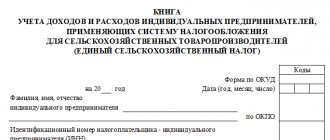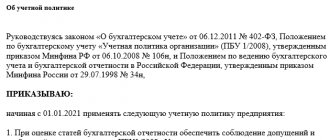Before you begin full-time work in the 1C 8.3 Accounting 3.0 program, you need to set up the accounting policy of the organization whose accounting you will be maintaining. In the case where the program keeps records of several organizations at once, it must be configured for each.
First, let's figure out where to find the accounting policy in 1C 8.3 Accounting. In the “Main” menu, select “Accounting Policy”. It is located in the “Settings” subsection.
Accounting policies in 1C 8.3 Accounting 3.0: where to find
Setting up UE in 1C is divided into several separate blocks:
- Accounting - section Main - Settings - Accounting policies;
- Tax accounting—section Main—Settings—Taxes and reports;
- Payroll accounting - section Salaries and personnel - Directories and settings - Salary settings.
Not all elements of accounting policy can be set in 1C settings. Some of them are not implemented to work automatically.
Let's look at the basic settings by block.
If you are a subscriber of the BukhExpert8 , then read additional material on the topic:
- Accounting policy designer
- Examples of UE and normative part in BU and NU
Settings when entering a new organization
If you are just starting to keep records, then when entering data about the organization, the system will prompt you to indicate the type of activity (individual entrepreneur or legal entity), as well as determine the taxation system.
Fig.7 Type of organization
Fig.8 Legal entity
The main setup begins with this step. The program will automatically enter the initial data when saving information about the company. In the future, by clicking on the hyperlink of the same name, these data can be adjusted in accordance with changed accounting requirements.
Fig.9 Accounting policy
Fig. 10 Change in accounting policy
In addition to the information card, the organization’s accounting policy is available in the “Main-Settings” menu section.
Fig.11 Main-Settings
Once we open it, we can configure other necessary parameters.
Fig. 12.1 Setting up accounting policy parameters
Fig. 12.2 Completing setting up accounting policy parameters
As such, the setup is divided into accounting setup and tax accounting setup.
Setting up accounting policies in 1C 8.3: accounting
Fill in the accounting settings through the Main - Settings - Accounting Policies section.
Method for assessing MPZ
Select Inventory valuation method :
- By average - disposal of inventories is carried out at a sliding cost, which at the end of the month is adjusted to the weighted average. Read more Average write-off of materials for general business needs;
- According to FIFO , the disposal of inventories is accounted for in batches: the first one came, the first one left.
The method for assessing the inventory is set the same for BU and NU. The disposal of inventories at the cost of each unit is not implemented in 1C. When drawing up the UE, take these nuances into account.
Method for evaluating goods in retail
The assessment of goods in ATT and NTT is reflected:
- At the cost of acquisition - goods are received at the warehouse at the cost of the supplier on account 41.02. The trade margin when they are disposed of is not reflected, and the cost of writing off goods is determined according to the Inventory valuation method .
- At sales price - goods are received at the warehouse at the selling price on account 41.11 or 41.12. The trade margin is recorded on account 42.
In NU, retail goods are valued only at acquisition cost.
Cost accounting
The main cost accounting account is the account set by default in documents when purchasing services or works. More details Automatic substitution of cost accounts.
When conducting production activities, indicate the costs accounted for on account 20. This setting affects the automatic closure of account 20 by item groups (NG):
- Product release - finished products are produced.
To close account 20 when releasing products, enter the document Production report for the shift . If there is no issue for NG, then account 20 for it will not be closed.
- Performing work, providing services to customers - services or work are performed, regardless of whether the cost per unit of work/service is calculated or not. Costs field : Without taking into account revenue - costs are always recognized in the current period in full, unless work in progress is entered. When closing the month, the posting Dt 90.02 Kt 20 is generated, even if there was no sales on NG.
Direct costs for services, unlike work, can be taken into account entirely in the expenses of the reporting period: without distribution to the balances of work in progress (clause 2 of Article 318 of the Tax Code of the Russian Federation). When performing work with the selected option Without taking into account revenue for work in progress, do not forget to enter the document WIP Inventory .
- Taking into account all revenue , costs are recognized in the current period only if sales are completed during the New Year. If there was no sale, account 20 will not be closed.
- Taking into account revenue only from production services - costs are recognized in the current period only if the implementation of work/services is documented in the document Provision of production services . Otherwise, account 20 will not be closed, even there is revenue from the New Year, but it is documented in a different document: for example, a Sale (deed, invoice) .
An important setting is closing the “General business expenses” account. There should be no balance on it at the end of the month.
Close it:
- to account 90.08 (direct costing);
- to the account 90.02.
If you select In the cost of products, works, services , then the costs of the account are distributed according to certain rules specified in the link Methods for distributing indirect costs.
The Factory General Expenses account should not have a balance. If you use it in accounting, set it to Indirect Cost Allocation Methods .
Subaccounts of account 44 “Sales expenses” are closed to account 90.07 “Sales expenses”, so no distribution needs to be specified for them.
If you are a subscriber of the BukhExpert8 , then read additional material on the topic:
- Implementation of work
- Provision of services: direct costs are taken into account at the time of their implementation
- Sales of products
- How to correctly decide on the accounting method for the trade of a small enterprise? Pitfalls of the direct costing method?
Calculation of production costs
Setting up the calculation of production costs regulates:
- accounting for output at planned cost;
- application of the account “Output of products (works, services)” to account for deviations from the planned cost;
- sequence of cost calculation for the production of semi-finished products or auxiliary production services.
If you are a subscriber of the BukhExpert8 , then read additional material on the topic:
- Production of products at planned prices
- Release of products without planned prices
Cash accounting
If the checkbox is checked, all money movements are reflected using account 57, regardless of the duration of their movement.
Estimated values
If the checkbox is checked, it allows you to automatically create a reserve for doubtful debts in accounting using the routine operation Calculation of reserves for doubtful debts at the end of the month. If the box is not checked, then reserves are created manually: creating reserves in accounting is the responsibility of the taxpayer.
Reserves are automatically formed only if there is an overdue debt in rubles. The amount is determined as a percentage of the balance on DT accounts 62, 76.06 in the following order:
- 50% if the delay is more than 45 days;
- 100% if the delay is more than 90 days.
PBU 18
In the BU settings, you can enable the ability to use PBU 18 in accordance with:
- the current edition of PBU 18/02: the calculation of differences is carried out in the regulatory operation Calculation of income tax using the cost method.
- calculation of differences is carried out in the routine operation Calculation of deferred tax according to PBU 18/02 using the balance sheet method.
The choice of applying PBU 18 does not affect the calculation of income tax, but only affects the reflection of differences.
OS accounting
The 1C settings do not reflect the elements of the software for accounting for fixed assets in accounting. Learn in more detail how the UE for the OS is reflected in 1C.
Calculation of production costs and accounting for other areas
Calculation of production costs involves the use of options:
- the planned cost of production is used;
- the cost of semi-finished products is calculated;
- The cost of services is calculated by our own division.
Checking the option for calculating the cost of semi-finished products reveals an additional choice of the sequence of production stages (processing stages):
- automatically;
- manually.
In itself, calculating the cost of semi-finished products is convenient in such production, where a product - a part - is made from a material, say, a sheet of iron. On the one hand, this is a finished product, on the other hand, it can be used as a semi-finished product in the production of, for example, an engine.
When choosing automatic determination of the sequence of production stages, it is necessary to configure the counter release of products (services). To do this, click on the hyperlink of the same name and click the “Create” button to configure the appropriate fields. In fact, the cost of the counter release should be excluded from the cost of the batches of products released before it.
If marked “manually”, then the hyperlink should set the order of divisions for closing cost accounts.
Similar settings are created and/or when choosing to calculate the cost of services by your own department.
Setting up accounting policies in 1C 8.3: ZUP
UP in terms of salary include:
- vacation reserve;
- accounting of insurance premiums;
- personal income tax accounting.
If you are a subscriber of the BukhExpert8 , then read additional material on the topic:
- Salary settings: 1C
Vacation reserve
The need for automatic formation of vacation reserves and its configuration is carried out on the Vacation reserves of the salary accounting settings in the Administration section - Program settings - Accounting parameters - Salary settings - link Salary accounting procedure.
On the Leave Reserves , uniform rules are set for NU and BU in accordance with Art. 324.1 Tax Code of the Russian Federation.
Calculate the “vacation” reserve from the section Salaries and personnel - Salary - Accrual of estimated vacation obligations. At the end of the month, check its accrual, since the Accrual of vacation reserve will not generate an error if the Accrual of estimated vacation liabilities is empty.
Insurance premiums
Set up insurance premiums in the Main section - Settings - Taxes and reports - Insurance premiums tab.
Please indicate:
- type of insurance premium rate;
- Are there any special features for calculating insurance premiums (are there pharmacists, flight crew members, etc.);
- the rate of premiums for insurance against industrial accidents and occupational diseases;
- divisions with preferential contribution rates;
- the need to transfer voluntary contributions.
Whether the organization belongs to the regions of the FSS pilot project for direct payment of benefits is set in the salary settings on the Salary .
Personal income tax
In the personal income tax settings, set the procedure for applying standard deductions. To do this, go to the Main section - Settings - Taxes and reports - Personal Income Tax tab.
Tab “Settlements with counterparties”
For management accounting purposes, on this tab for all organizations of the enterprise, you can specify payment terms for customers and payment terms for suppliers.
If necessary, similar parameters can be specified in the agreement with a specific counterparty. The payment terms specified in the agreement with the counterparty for the program are of higher priority than the payment terms specified in the accounting settings.
Arrears based on payment terms can be further analyzed in the reports of the Anti-Crisis Management Center. It is located on the function panel, on the “Manager” tab. There are two groups of reports on debt settlements.
Settlements with customers.
- Dynamics of customer debt.
- Buyers' debt.
- Buyers' debt by debt terms.
- Overdue debt from buyers.
Settlements with suppliers
- Dynamics of debt to suppliers.
- Debt to suppliers.
- Debt to suppliers by debt terms.
- Overdue debts to suppliers.
Setting up accounting policies in 1C 8.3 OSNO
Set the UE settings for income tax in the Main section - Settings - Taxes and reports - Income tax tab.
Please indicate:
- Depreciation method for depreciable property.
- How the cost of workwear and special equipment is repaid at NU.
- The need to form reserves for doubtful debts. In NU, the creation of reserves is the right of the taxpayer.
- Separation of expenses and income.
- Procedure for making advance payments.
Setting up accounting policies in 1C 8.3 OSNO: production
To distinguish between direct and indirect costs in NU, specify the criteria for direct costs using the link List of direct costs .
To differentiate between income from the sale of purchased goods and products of your own production, specify a list of item groups related to your own production using the link Item groups for sales of products and services .
If you are a subscriber of the BukhExpert8 , then read additional material on the topic:
- Detailed completion of the Income Tax tab
- Accounting policy for tax accounting of fixed assets
- Transition to making advance payments of income tax based on actual profit
- Transition to monthly payment of advance payments for income tax from the beginning of the year
Setting up accounting policies in 1C 8.3 USN Income minus expenses
For the simplified tax system Income minus expenses, set the procedure for recognizing expenses in the Main section - Settings - Taxes and reports - simplified tax system tab.
If you are a subscriber of the BukhExpert8 , then read additional material on the topic:
- Procedure for recognizing expenses for the purchase of goods (STS)
Printing accounting policies
You can print the UE from the form of its settings in the Main - Settings - Accounting Policy section.
Before printing, all settings must be made, since the completeness of the reflection of all elements in it is affected not only by the UE settings, but also by the functionality settings.
If you are a subscriber to the BukhExpert8 system, then read additional material on the topic:
- Functionality settings
If you haven't subscribed yet:
Activate demo access for free →
or
Subscribe to Rubricator →
After subscribing, you will have access to all materials on 1C Accounting, recordings of supporting broadcasts, and you will be able to ask any questions about 1C.
Did the article help?
Get another secret bonus and full access to the BukhExpert8 help system for 14 days free of charge
Tab "Accounts with personnel"
The parameters set on this tab certainly apply to all organizations of the enterprise.
Payroll accounting and personnel records.
In this section, you must indicate in which program you plan to keep personnel records and perform payroll calculations.
- In this program . Activation of this radio button indicates that payroll calculations and personnel accounting are planned to be performed in the 1C Accounting 8 program.
- In an external program . Activation of this radio button indicates that payroll calculations and personnel accounting are planned to be performed in an external program. Usually this is a specialized program 1C Salary and personnel management 8.
Activating the radio button “In an external program” will block all personnel and settlement documents in the 1C Accounting 8 program.
That is, they cannot be used. This allows you to avoid calculation errors resulting from overlapping data from different programs. Analytical calculation with personnel.
Settlements with personnel can be carried out collectively for all employees or separately for each employee.
- For each employee . This radio button must be activated if personnel accounting and salary calculations are performed in the 1C Accounting 8 program. Otherwise, it will be impossible to generate those regulated reports that indicate information for each employee. For example, prepare data for transfer to the Pension Fund.
- Summary for all employees . It is advisable to activate this radio button if personnel accounting and salary calculations are performed in an external program, for example, 1C Salary and personnel management 8.
Activating the radio button “For each employee” adds the subaccount “Employees of organizations” to the following accounting accounts.
- Account 70 “Settlements with personnel for wages”.
- Account 76.04 “Settlements on deposited amounts.”
- Account 97.01 “Payroll expenses for future periods.”
On the contrary, activating the radio button “Summary for all employees” deletes the subaccount “Employees of organizations” on these accounts.
Accountants often have a question about which analytics option to choose: “For each employee” or “Summary for all employees.” For calculations in the accounting program itself, everything is usually clear: only “For each employee.”
But for calculations performed in an external program, there are options. And some accountants, without hesitation, choose the first option - “For each employee.” The following arguments are usually given in favor of such a decision.
- Salary calculations must be carried out for each employee . Who can argue against this! But the accounting program does not need this information. All detailed calculations for employees are carried out in an external program, for example, 1C Salary and personnel management 8.
- It is necessary to generate standard reports in an accounting program . Of course you can, but you shouldn’t kill your accounting program for the sake of it. The 1C Salary and Personnel Management 8 program has many specialized reports on personnel accounting and accruals. Moreover, such reports do not even exist in the accounting program.
- It is necessary to prepare and generate regulated reports on payroll calculations . All regulated reports can be prepared in the 1C Salary and Personnel Management 8 program. If desired, the accountant can prepare some of these reports in the accounting program after a consolidated loading of data from the calculation program.
- In the accounting program, you must have all the postings for accruals and deductions for each employee . For what?
The following counterarguments can be given against the last argument.
Let us recall that personnel accounting and payroll calculations in the 1C Salary and Personnel Management 8 program assumes that monthly calculation data is uploaded from this program to the 1C Accounting 8 program. Depending on the settings, they will be uploaded collectively or separately for each employee.
Let's assume that employees only have a salary. For this case, the settlement program creates 7 accounting entries for each employee. This includes payroll and personal income tax and 5 entries for insurance premiums. This means that if there are 100 people in an organization, then 8,400 accounting entries need to be downloaded per year.
And, if we add here sick leave, insurance payments, allowances, compensation, bonuses, etc. the number of uploaded transactions will increase even more.
The question arises: why should an accounting program be loaded with unnecessary information every month? Swelling of the information base can lead to a significant decrease in the performance of the accounting program.
Therefore, if there are no serious items to upload with detail by employee, we upload them in summary form. When preparing regulatory reports, if something doesn’t go well in terms of payroll calculations and insurance premiums, the accountant can easily determine where the ears are coming from. Gives instructions to the calculator. It finds errors, corrects them, and uploads the updated data back into the accounting program.
Unfortunately, there are cases when it is impossible to do without detailed unloading. You can find out more about this in the article “Transferring salaries to banks in the 1C Salary and Personnel Management program 8: there is no salary project.”







